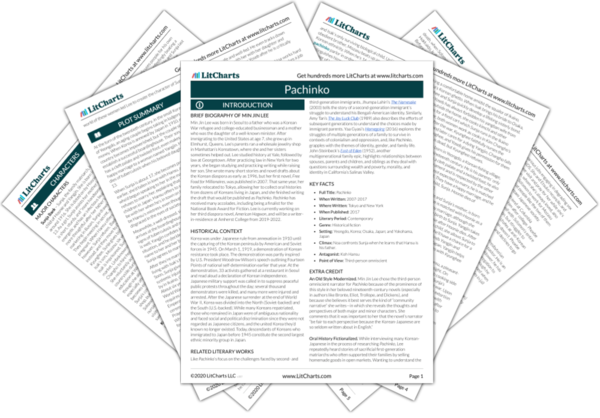Welcome to the LitCharts study guide on Min Jin Lee's Pachinko. Created by the original team behind SparkNotes, LitCharts are the world's best literature guides.
Pachinko: Introduction
Pachinko: Plot Summary
Pachinko: Detailed Summary & Analysis
Pachinko: Themes
Pachinko: Quotes
Pachinko: Characters
Pachinko: Terms
Pachinko: Symbols
Pachinko: Literary Devices
Pachinko: Theme Wheel
Brief Biography of Min Jin Lee

Historical Context of Pachinko
Other Books Related to Pachinko
Key Facts about Pachinko
- Full Title: Pachinko
- When Written: 2007-2017
- Where Written: Tokyo and New York
- When Published: 2017
- Literary Period: Contemporary
- Genre: Historical fiction
- Setting: Yeongdo, Korea; Osaka, Japan; and Yokohama, Japan
- Climax: Noa confronts Sunja when he learns that Hansu is his father.
- Antagonist: Koh Hansu
- Point of View: Third-person omniscient
Extra Credit for Pachinko
An Old Style Modernized. Min Jin Lee chose the third-person omniscient narrator for Pachinko because of the prominence of this style in her beloved nineteenth-century novels (especially in authors like Bronte, Eliot, Trollope, and Dickens), and because she believes it best serves the kind of “community narrative” she writes—in which she reveals the thoughts and perspectives of both major and minor characters. She comments that it was important to her that the novel’s narrator “be fair to each perspective because the Korean-Japanese are so seldom written about in English.”
Oral History Fictionalized. While interviewing many Korean-Japanese in the process of researching Pachinko, Lee repeatedly heard stories of sacrificial first-generation matriarchs who often supported their families by selling homemade goods in open markets. Wanting to understand the world of these women led Lee to create the character of Sunja.







